ZENworks Endpoint Security Management - VPN Enforcement
This document provides test scenarios that show you how to use ZENworks Endpoint Security Management to initiate a VPN session when a device is in an unknown location and also lock down the firewall to block all network traffic except for VPN server traffic.
1.0 Prompting a User to Initiate a VPN Session When in an Unknown Location
As the ZENworks administrator, you want mobile users to use VPN when they are in unsecure locations. The following steps help you import a predefined VPN Enforcement policy that prompts users to start a VPN session whenever their device is in the default Unknown location.
-
Import the Firewall policy:
-
Copy the following files to a directory on the ZENworks Primary Server:
When you click a filename, the file will either be opened, saved, or you will be prompted to open or save it. You need to save the file. If it opens, click File > Save.
If you downloaded the Endpoint Security Resource Kit, you can copy the files from the PolicyExamples directory.
-
On the Primary Server, open a command prompt, change to the directory where you copied the files, then run the following commands one at a time, entering your ZENworks administrator username and password when prompted:
zman epi "Location Assignment" policykey.txt Location-Assignment.xml
zman epi "VPN - Session Prompt" policykey.txt VPN-Session-Prompt.xml
A message similar to the following is displayed when a policy is successfully imported:
Successfully created the object "Location Assignment" in "/Policies".
-
-
Validate the policy import:
-
In ZENworks Control Center, click Policies to display the Policies list with the two imported policies.

-
Click the Location Assignment policy, then click its Details tab.
There are six locations included in the policy: the standard Unknown location and five locations that start with BB_ZESM_ZONE. The BB_ZESM_ZONE locations were imported with the policy and added as locations in your zone. If you go to the Locations page (Configuration > Locations), you will see them listed.
For this test scenario, only the Unknown and BB_ZESM_ZONE_VPN Switch to Location locations are used. The other locations are used with the test scenarios for other policies (Wireless, USB, and Scripting).
The locations do not include any network environments, which means that the only way a device can switch to one of the locations is for the device’s user to manually change to the location. For this reason, each location is configured to appear in the Security Locations list (available when right-clicking the ZENworks icon on the device) and to allow the user to manually change to the location.
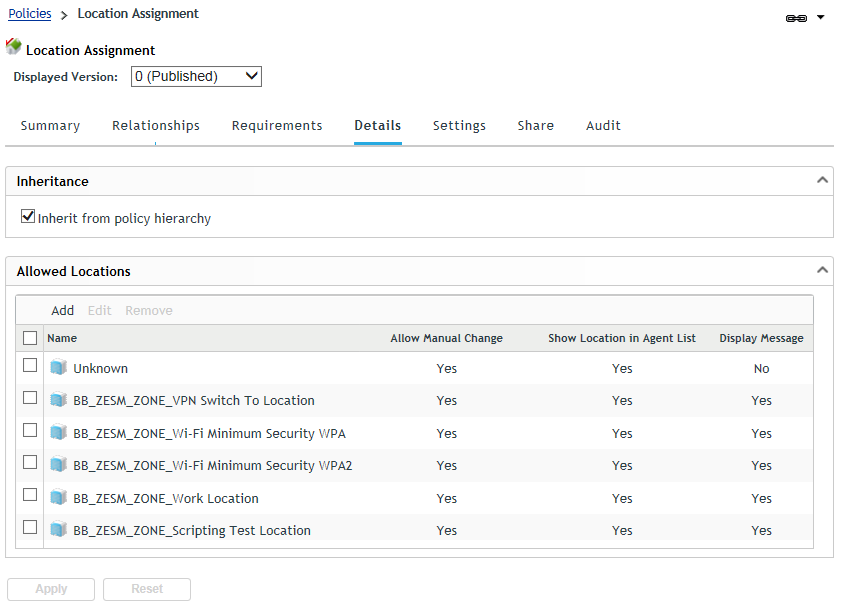
-
Return to the Policies list.
-
-
View the VPN - Session Prompt policy to see how it is configured:
-
Click the VPN - Session Prompt policy, then click its Details tab.
The Trigger Locations list includes the Unknown location. This causes the policy to be launched whenever the device moves into the Unknown location.

The Connect Settings panel contains the message that will be displayed prompting the user to initiate a VPN session:
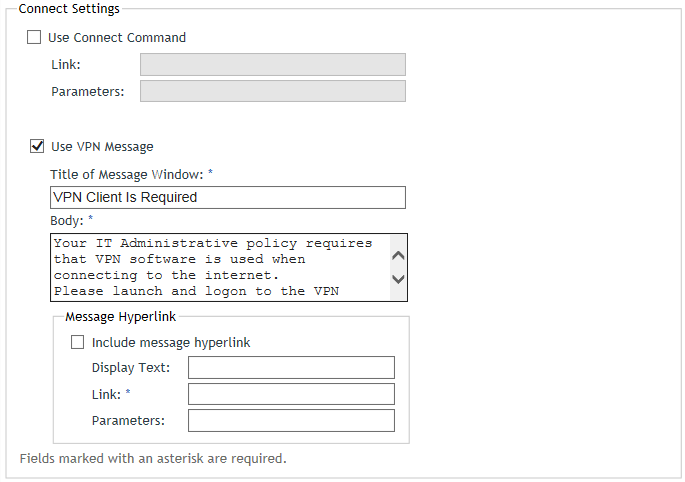
The VPN Location displays the switch-to-location. This location can be configured with other policies you want enforced (such as the restrictive Firewall policy explained in the next scenario, Enforcing a Restrictive Firewall During the VPN Session) while the device remains in the VPN location. For this scenario, the VPN location (BB_ZESM_ZONE_VPN Switch to Location) does not have any policies that it applies.

-
Return to the Policies list.
-
-
Assign the Location Assignment and VPN policies to a device:
-
In the Policies list, select the check boxes next to the following policies:
-
Location Assignment
-
VPN - Session Prompt
-
-
Click Action > Assign to Device, then follow the prompts to assign the policies to the appropriate device.
When prompted for the policy conflict method, you can leave it set to User Precedence.
-
-
Test the VPN policy on the assigned device:
-
On the device, right-click the ZENworks icon, then click Refresh to retrieve the new policies.
When the device finishes refreshing and the policies are applied, the location is set to the Unknown location. The Unknown location applies the VPN - Session Prompt policy, which causes the location to be switched to the BB_ZESM_ZONE_VPN Switch to Location and the following prompt to be displayed:

-
Click OK to dismiss the prompt.
-
Right-click the ZENworks icon > click Security Location to see the device is in the BB_ZESM_ZONE_VPN Switch to Location.

-
-
For the purpose of this test scenario, you need to unassign the VPN - Session Prompt policy from the device (in ZENworks Control Center) to exit the BB_ZESM_ZONE_VPN Switch to Location on the device.
2.0 Enforcing a Restrictive Firewall During the VPN Session
This scenario assumes that you have already completed the Prompting a User to Initiate a VPN Session When in an Unknown Location scenario. This scenario builds on that scenario, so if you have not completed it, do so before continuing.
As the ZENworks administrator, when a user is in a location that requires a VPN session you want to ensure that all network traffic is passed through the VPN server.
The following steps help you import a predefined restrictive Firewall policy that is enforced whenever the device switches to the VPN location.
-
Import the Firewall policy:
-
Copy the following files to a directory on the ZENworks Primary Server:
When you click a filename, the file will either be opened, saved, or you will be prompted to open or save it. You need to save the file. If it opens, click File > Save.
If you downloaded the Endpoint Security Resource Kit, you can copy the files from the PolicyExamples directory.
-
On the Primary Server, open a command prompt, change to the directory where you copied the files, then run the following command, entering your ZENworks administrator username and password when prompted:
zman epi "Firewall - Restrictive VPN" policykey.txt VPN-Firewall.xml
A message similar to the following is displayed when a policy is successfully imported:
Successfully created the object "Firewall - Restrictive VPN" in "/Policies".
-
-
Validate the policy import and modify the Firewall policy as needed:
-
In ZENworks Control Center, click Policies to display the Policies list with the imported policies.
The Firewall - Restrictive VPN policy is listed along with the Location Assignment and VPN - Session Prompt policies that were imported as part of the Prompting a User to Initiate a VPN Session When in an Unknown Location scenario.

-
Click the Firewall - Restrictive VPN policy, then click the Details tab.
Notice that this location-based policy is configured to be available in the VPN location:

The Default Behavior for the firewall is Closed, which means that any ports, protocols, and addresses that need to be open must be explicitly defined. In this case, DHCP and DNS are open and several standard ACLs are allowed. In addition, the VPN server is added as a trusted ACL. The combination of these settings allow network traffic to the VPN server address but block all other addresses.
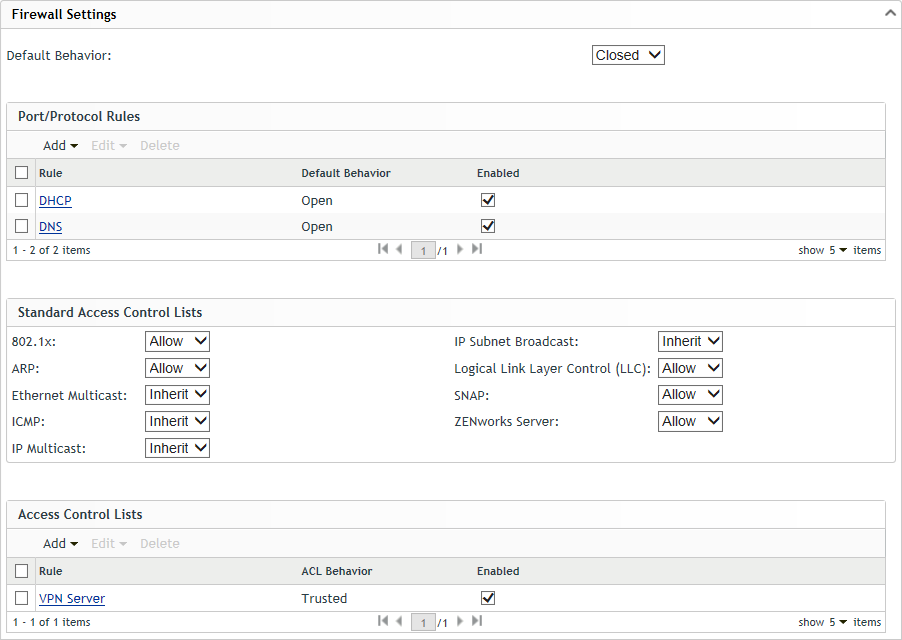
-
Click VPN Server to display the Edit Access Control List dialog box.
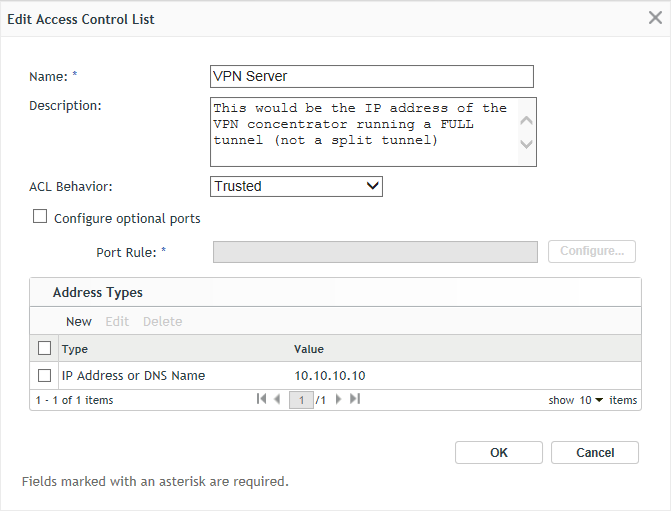
-
In the Address Types list, change the address to your VPN server address.
-
Click OK to save the address change.
-
Click Apply to save the policy.
-
Return to the Policies list.
-
-
Assign the Location Assignment, VPN, and Firewall policies to a device:
-
In the Policies list, select the check boxes next to the following policies:
-
Location Assignment
-
VPN - Session Prompt
-
Firewall - Restrictive VPN
-
-
Click Action > Assign to Device, then follow the prompts to assign the policies to the appropriate device.
If the Location Assignment and VPN - Session Prompt VPN policies are already assigned to the device because of a previous scenario, you are prompted whether or not you want to replace the assignments. You can keep the current assignments.
When prompted for the policy conflict method, you can leave it set to User Precedence.
-
-
Test the Firewall policy on the assigned device:
-
On the device, right-click the ZENworks icon, then click Refresh to retrieve the new policies.
When the device finishes refreshing and the policies are applied, the location is set to the Unknown location. The Unknown location applies the VPN - Session Prompt policy, which causes the location to be switched to the BB_ZESM_ZONE_VPN Switch to Location and the following prompt to be displayed:

-
Click OK to dismiss the prompt.
-
Right-click the ZENworks icon > click Security Location to see that the device is in the BB_ZESM_ZONE_VPN Switch to Location.

-
-
Open a command prompt and ping your VPN server address to verify that it is accessible.
The policy also allows access to ZENworks Servers so that the ZENworks Agent can continue to communicate with the system. You can ping a ZENworks Server to verify if desired.
-
Use your normal administrative tools to verify that all other network traffic is blocked.
-
For the purpose of this test scenario, you need to unassign the VPN - Session Prompt policy from the device (in ZENworks Control Center) to exit the BB_ZESM_ZONE_VPN Switch to Location on the device.
3.0 Launching a VPN Client to Initiate a VPN Session When in an Unknown Location
This scenario assumes that you have already completed the Prompting a User to Initiate a VPN Session When in an Unknown Location and Enforcing a Restrictive Firewall During the VPN Session scenarios. This scenario builds on those scenarios, so if you have not completed them, do so before continuing.
As the ZENworks administrator, when a user is in a location that requires a VPN session you want to automatically launch the VPN client for the user and then ensure that only network traffic through the VPN session is allowed.
The following steps help you import a predefined VPN policy that launches a VPN client when a device is in the default Unknown location. The Firewall policy used in Enforcing a Restrictive Firewall During the VPN Session is also applied to block all network access that is not through the VPN server.
-
Import the VPN policy:
-
Copy the following files to a directory on the ZENworks Primary Server:
When you click a filename, the file will either be opened, saved, or you will be prompted to open or save it. You need to save the file. If it opens, click File > Save.
If you downloaded the Endpoint Security Resource Kit, you can copy the files from the PolicyExamples directory.
-
On the Primary Server, open a command prompt, change to the directory where you copied the files, then run the following command, entering your ZENworks administrator username and password when prompted:
zman epi "VPN - Session Launch" policykey.txt VPN-Session-Launch.xml
A message similar to the following is displayed when a policy is successfully imported:
Successfully created the object "VPN - Session Launch" in "/Policies".
-
-
Validate the policy import and modify the VPN policy as needed:
-
In ZENworks Control Center, click Policies to display the Policies list with the imported policies.
The VPN- Session Launch policy is listed along with the Location Assignment, VPN - Session Prompt, and Firewall - Restrictive VPN policies that were imported as part of the previous scenarios.
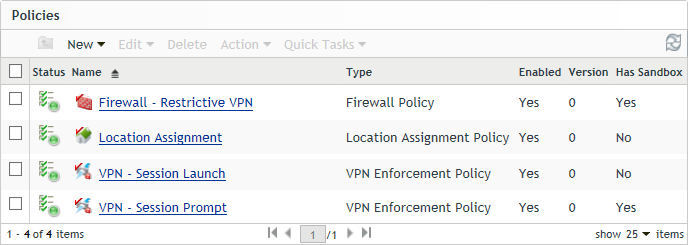
-
Click the VPN - Session Launch policy, then click the Details tab.
The policy is configured the same as the VPN - Session Prompt policy with the exception that a connect command is used instead of a VPN message prompt. The connect command launches a VPN client. The user must then log in using the client.
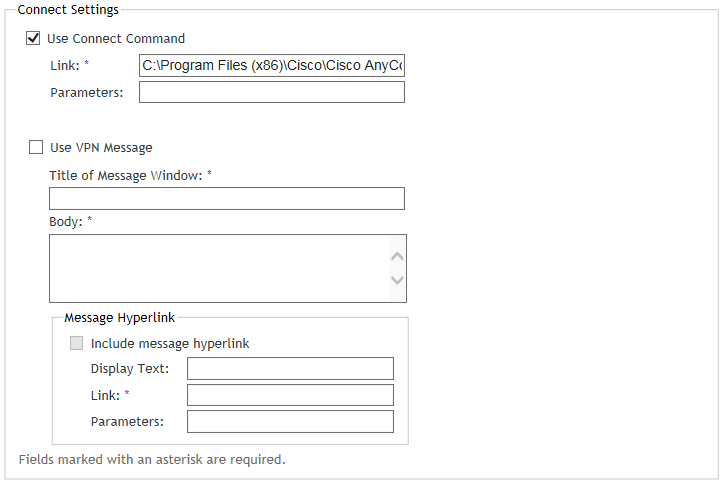
-
In the Link field, enter the command needed to launch your VPN client.
-
Click Apply to save the policy.
-
Return to the Policies list.
-
-
Assign the Location Assignment, VPN, and Firewall policies to a device:
-
In the Policies list, select the check boxes next to the following policies:
-
Location Assignment
-
VPN - Session Launch
-
Firewall - Restrictive VPN
-
-
Click Action > Assign to Device, then follow the prompts to assign the policies to the appropriate device.
If the Location Assignment and Firewall - Restrictive VPN policies are already assigned to the device, you are prompted whether or not you want to replace the assignments. You can keep the current assignments.
When prompted for the policy conflict method, you can leave it set to User Last.
-
If the VPN - Session Prompt policy is assigned to the device (from the previous scenarios), remove the policy assignment from the device. To do so, click the policy, click Relationships, then remove the device from the Device Assignments list.
-
-
Test the policy on the assigned device:
-
On the device, right-click the ZENworks icon, then click Refresh to retrieve the new policies.
When the device finishes refreshing and the policies are applied, the location is set to the Unknown location. The Unknown location applies the VPN - Session Launch policy, which causes the location to be switched to the BB_ZESM_ZONE_VPN Switch to Location and the VPN client to be launched.
-
Right-click the ZENworks icon > click Security Location to see that the device is in the BB_ZESM_ZONE_VPN Switch to Location.

-
For the purpose of this test scenario, you need to unassign the VPN - Session Launch policy from the device (in ZENworks Control Center) to exit the BB_ZESM_ZONE_VPN Switch to Location on the device.
-
4.0 Legal Notice
For information about legal notices, trademarks, disclaimers, warranties, export and other use restrictions, U.S. Government rights, patent policy, and FIPS compliance, see https://www.novell.com/company/legal/.
Copyright © 2016 Novell, Inc., a Micro Focus company. All Rights Reserved.